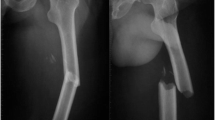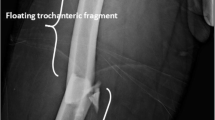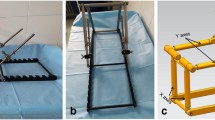Abstract
Purpose
This study aims to assess the outcomes of displaced femoral shaft fractures (DFSFs) treated by antegrade nailing with the assistance of a newly invented intramedullary (IM) reduction device.
Methods
From December 2012 to August 2013, 43 adult patients with unilateral DFSFs, including 31 males and 12 females, were enrolled into this study. During the operation, the device was used to adjust the direction of guide wire to insert it into the medullary cavity of distal femur and used as a “joystick” to align the femoral shaft fractures before the insertion of IM nail. The operative time and fluoroscopy time were recorded. Follow-up was conducted to assess the fracture union and functional recovery of the affected limbs.
Results
The IM reduction device was used intra-operatively to advance the guide wire into the distal femoral medullary cavity successfully in all 43 cases, with a single attempt in 37 cases and two or three attempts in six cases. The average operative time and fluoroscopy time were 58.3 minutes (40–85 minutes) and 9.2 seconds (4.1-21.8 seconds), respectively. All fractures healed well on an average of 5.4 months post-operatively. No limb-length discrepancy or observable malalignment was noted at the follow ups.
Conclusions
The IM reduction device can facilitate the insertion of a guide wire into the distal femoral medullary cavity in a closed and controllable manner, be used as a “joystick” to align the femoral shaft fracture, and subsequently facilitate IM nail insertion in the proper position.





Similar content being viewed by others
References
Zhang Y (2014) Clinical Epidemiology of Orthopedic Trauma, 2nd edn. People’s Medical Publishing House, Beijing
Chen W, Zhang T, Wang J, Liu B, Hou Z, Zhang Y (2015) Minimally invasive treatment of displaced femoral shaft fractures with a rapid reductor and intramedullary nail fixation. Int Orthop [Epub ahead of print]. doi:10.1007/s00264-015-2829-0
Yang KH, Han DY, Jahng JS, Shin DE, Park JH (1998) Prevention of malrotation deformity in femoral shaft fracture. J Orthop Trauma 12(8):558–562
Bonnevialle P, Laques D, Fabre G, Mansat P, Rongieres M, Bellumore Y, Mansat M (2002) Femoral shaft fractures in the elderly treated by intramedullary nailing. Rev Chir Orthop Reparatrice Appar Mot 88(1):41–50
Pfister U (2010) Reamed intramedullary nailing. Orthopade 39(2):171–181
Taitsman LA, Lynch JR, Agel J, Barei DP, Nork SE (2009) Risk factors for femoral nonunion after femoral shaft fracture. J Trauma 67(6):1389–1392
Lies A, Josten C, Muhr G (1993) Complications of intramedullary nailing and their prevention. Zentralbl Chir 118(6):342–350
Sabat D, Wangchuk T, Dhal A (2014) Inadvertent advancement of guide wire across the knee caused by incarcerated bone fragment at the nail tip during femoral nailing. Chin J Traumatol 17(2):118–120
Riehl JT, Widmaier JC (2009) Techniques of obtaining and maintaining reduction during nailing of femur fractures. Orthopedics 32(8):581
Ziran BH, Morganstein A (2014) Preventing eccentric reaming of the trochanter during trochanteric nailing. J Orthop Trauma 28(4):e88–90
Ciftdemir M, Tuncel SA, Ozcan M, Copuroglu C, Erem M (2015) Does electromagnetic-manual guided distal locking influence rotational alignment in antegrade femoral nailing? Int Orthop 39(3):507–512
Chen W, Wang J, Su YL, Zhang Q, Wang B, Li ZY, Zhang YZ (2011) Comparison of two kinds of intramedullary nails in the treatment of femoral shaft fractures in adults. Chin Med J (Engl) 124(23):3900–3905
Barquet A, Francescoli L, Rienzi D, Lopez L (2000) Intertrochanteric-subtrochanteric fractures: treatment with the long Gamma nail. J Orthop Trauma 14(5):324–328
Aiyer S, Jagiasi J, Argekar H, Sharan S, Dasgupta B (2006) Closed antegrade interlocked nailing of femoral shaft fractures operated up to 2 weeks postinjury in the absence of a fracture table or C-arm. J Trauma 61(2):457–460
Kim KC, Lee JK, Hwang DS, Yang JY, Kim YM (2007) Stabilizing subtrochanteric femoral fractures with an interlocked intramedullary nail using the 'Joystick' technique. Orthopedics 30(9):705–708
Faraj AA, Johnson VG (2002) Penetration injury of the hindfoot following intramedullary nail fixation of a tibial fracture. Acta Orthop Belg 68(2):178–181
Rajappa S, Kumar NS (2009) Unusual complication following intramedullary nailing of tibia: a case report. Cases J 2:7343
Author information
Authors and Affiliations
Corresponding author
Ethics declarations
Conflict of interest
This study was supported by the National Natural Science Foundation of China (Grant No. 81401789). No other conflict of interest exits.
Additional information
Wei Chen and Yongmin Jing contributed equally to this work.
Rights and permissions
About this article
Cite this article
Chen, W., Jing, Y., Lv, H. et al. Displaced femoral shaft fractures treated by antegrade nailing with the assistance of an intramedullary reduction device. International Orthopaedics (SICOT) 40, 1735–1739 (2016). https://doi.org/10.1007/s00264-015-3036-8
Received:
Accepted:
Published:
Issue Date:
DOI: https://doi.org/10.1007/s00264-015-3036-8




